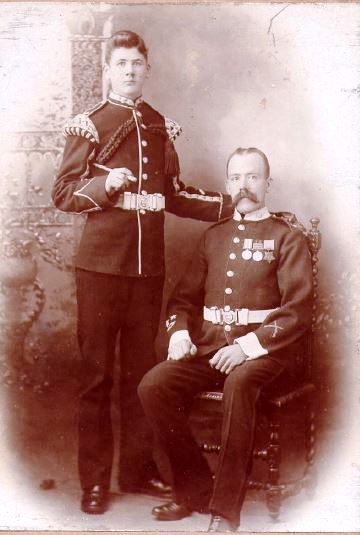
Sergeant William James Denton Milson 7813 D.C.M. 2nd Battalion Yorkshire Regiment.
This story was submitted by Andrew Hume Voegeli. Serjeant Milson was the brother of his maternal grandmother Lily Muriel Boyes (nee Milson) born in Beverley in 1896. William James Denton Milson was born on the 1st of February 1890 in the Parish of St Mary’s Beverley Yorkshire. He was the eldest of 6 children, his father was William Carr Milson and his mother was Ann Maria Milson, nee Cooper.
His father was a boot maker but did serve in several regiments including the Yorkshire Regiment. Young William enlisted in the Yorkshire Regiment aged 14 years and 7 months on the 24th of August 1904 as a drummer boy. He was 4 feet 11 inches tall, had a fair complexion, grey eyes and light brown hair. He was working as a message boy at that time. Before the outbreak of World War 1 he served in India.
On the 6th of October 1914 he landed at Zeebrugge and took part in the 1st Battle of Ypres. By 1915 his leadership skills led to his promotion to Serjeant. On the 15th of March 1915 he was awarded the Distinguished Conduct Medal (D.C.M.) for leading a rescue party for men trapped under continuous sniper fire.
The Yorkshire regiment gazette recorded this as follows:
“D.C.M.s have been awarded to Sergt Milsom, Cpl Wilson and Pte Howard for their work when the Boche’s mine was exploded at Givenchy on the 29th of November. The Brigadier at a special parade congratulate and the battalion.” His surname was incorrectly spelt Milsom!
In 1916 he was deployed to the southern sector of the Somme, west of the village of Maricourt. After a week of heavy bombardment of the German lines, the 1st of July saw the beginning of the Somme offensive. Milson was badly injured and sent to the hospital at Corbie. On the 4th of July he died of his wounds aged 26. He is buried in the Corbie communal cemetery extension (plot 1, row B grave 23), his grave inscription reads “He gave his life freely for God and his country in his arms securely folded”.

Explore more memories from the ribbon
-
Ernest Farrar
Judith Farrar told us the story of Ernest Holdsworth Farrar, the Great Uncle of her husband, Don. Ernest Farrar was born in 1882 in Leeds, after a spell at Teacher Training College in Isleworth, Middlesex he went on to study at Trinity College, Cambridge. He attained both a BA and BSc. After his graduation, Ernest spent some time in Dresden in Germany, and while the reasons for this sojourn are no longer known, it is highly likely that he continued as an academic at the University of Dresden. On his return to England Ernest was appointed to the Headship at Todmorden Secondary School. This important work continued after the outbreak of the First World War, but with the introduction of conscription in January 1916, Ernest was compelled to face several Tribunals when it was insisted that he enlist. The School Governors tried to intervene and to keep him as Headmaster, but he was sentenced to 6 months in Wormwood Scrubs prison. After an unsuccessful appeal, Ernest was sentenced by the Central London Tribunal to 6 months in Dartmoor Prison in 1917. His reasons for refusing to fight are given in the extract from the Yorkshire Post.
-
George Cattermole
George William Cattermole was born in Tudhoe County Durham in 1889 to George, a colliery worker, and Mary. He had two elder sisters called Sarah and Elizabeth. By 1906 he had left school and became a farm labourer. Aged 17 he travelled to Richmond and enlisted into the Yorkshire Regiment, 23rd April 1906. He was initially posted to the 3rd battalion and remains with the Yorkshire Regiment, recorded as living in the barracks at York during the 1911 census. By September 1918 Pte Cattermole is serving with the 2nd Battalion who were deployed near Arras. The war diaries describe the battalions involvement in an attack on the village of Epinoy on 27th September 1918 during which 5 officers and 127 other ranks are recorded as missing, possibly including George. Shortly after the regimental gazettes record George as a prisoner of war. He is released from captivity after the armistice on 11th November 1918 and returned to England.
-
Dixon Overfield
Si Wheeler submitted the story of his great grandfather, Dixon Overfield, but it’s also a great example of the impact of war on all those connected to the soldier who served. “Dixon was married to Margaret and they had a daughter Madge, born in 1915. Dixon enlisted in Filey in September 1916. He originally joined the Royal Field Artillery but soon got transferred to the 6th Battalion, the Yorkshire Regiment. He was sent to France and saw action at Arras, before being moved to Belgium. Dixon survived this fight, but twelve days later he too was killed in action at the Battle of Poelcappelle on the 9th of October 1917 when a shell burst just above himself and several comrades. Their bodies were never recovered. Dixon is remembered on the Tyne Cot Memorial. Dixon’s wife died in 1924, leaving my grandmother, Madge, aged 9, an orphan. Raised by two aunts, then entering service at 13, Madge was taken under the wing of her housekeeper boss, Lizzie Andrew and became part of her extended family. Aged 18, Madge moved to London to train as a nurse, working through the Blitz and marrying a Dunkirk evacuee soldier, my granddad, Harry Wheeler. Harry didn’t mind where they settled to start married life, so they moved to Swanland in East Yorkshire, where Lizzie lived. My parents live there to this day.”
